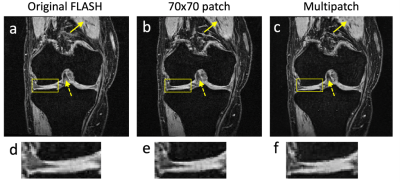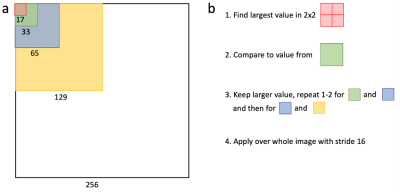Bragi Sveinsson1,2 and Matthew S Rosen1,2,3
1Martinos Center, Massachusetts General Hospital, Boston, MA, United States, 2Harvard Medical School, Boston, MA, United States, 3Physics, Harvard University, Cambridge, MA, United States
1Martinos Center, Massachusetts General Hospital, Boston, MA, United States, 2Harvard Medical School, Boston, MA, United States, 3Physics, Harvard University, Cambridge, MA, United States
Contrast synthesis with a cGAN analyzing image patches of multiple sizes can outperform a conventional network using single patch sizes.

Figure 3: (a) A ground truth FLASH image. (b) An image constructed from DESS and TSE scans to synthesize the image in panel a. The network looked at single patch sizes of 70×70 pixels to determine if the image was real or generated. (c) An image constructed by using a multi-patch discriminator as shown in Figure 1. The single-patch discriminator in panel b creates new structures (solid arrow) and loses contrast (dashed arrow) compared to the multipatch discriminator in panel c. The undesirable creation of new structure is also shown in the zoomed-in panels (d)-(f).

Figure 1: (a) The presented network uses a discriminator that examines different sized patches of an image to determine if they display real or generated data. The patch sizes are designed so that a 2×2 matrix of one patch size (with an overlap of one pixel) has the same size as the next largest patch. (b) The largest discriminator value in such a 2×2 matrix is selected and compared to the corresponding next largest patch. The larger value from that comparison is stored for that region and the process then repeated for the next patch size. This is applied over the whole image, using a stride of 16.